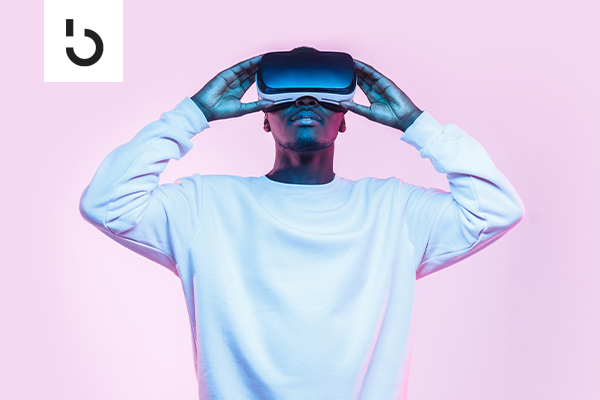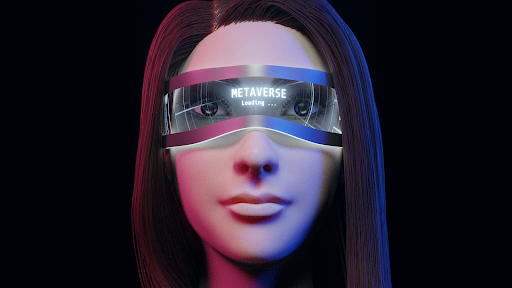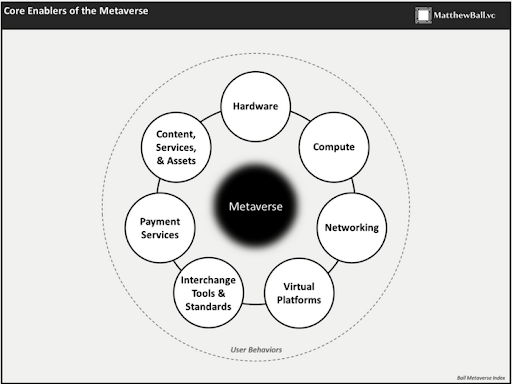
For crypto investors, The Metaverse reached several milestones in 2021, as tokens like MANA and SAND reached all-time highs of $5.85 and $8.44, respectively. In addition, the “floor price” (or minimum investment) of virtual land in Decentraland and The Sandbox reached as high as $10,000.
However, the 2022 crypto bear market has erased the gains, potentially impacting the ecosystem’s growth potential. Currently, MANA and SAND trade at around $0.65 and $0.78. The floor price for Decentraland parcels is is now approximately $2,300, and about $1,800 for The Sandbox.
Do these Metaverse projects still promise growth and revolutionary change in how humans interact with each other: a “parallel plane of existence“? This post digs into the ecosystem’s current state and investment potential.

What is the Metaverse?
First used in the 1992 sci-fi novel Snow Crash by Neal Stephenson, the Metaverse was a digital world that provided realistic 3D experience to users. In the book, you could meet your friends and colleagues in virtual worlds; shop using virtual currencies or tokens; buy, build, and develop virtual real estate.
You could enter and explore this digital environment using virtual reality headsets and augmented reality goggles, using this “second plane of existence” for everything from business meetings to entertainment.
More recently, Metaverse expert Matthew Ball defined it as a “parallel plane of existence,” explaining “The Metaverse is a new era unfolding in front of our eyes.”
In his bestselling book The Metaverse: And How it Will Revolutionize Everything (also available for free on his website, or in short form in this video), describes it as “an interoperable network of 3D worlds with a massive scale rendered in real-time.”
(He clarifies the difference between the Metaverse and virtual reality, adding that the latter is only a minor constituent of the former.)
The Metaverse isn’t a new concept. It is the product of years of continuous technological revolution, from the invention of computers, to the growth of personal computing, to the breakthroughs of the Internet and mobile computing.
Instead of swiping and staring at tiny screens, the Metaverse will allow us to enter into these worlds, in a variety of ways. But to do that, a number of key technologies need to still be developed and matured.
So while the Metaverse may still be in its infancy, many tech companies and investors see massive growth potential — anywhere from $800 billion to over $5 trillion, depending on whom you ask.
For crypto investors, here are some of the trends to watch and explore:

Emerging Trends in the Metaverse
Investors will do well to watch these trends, looking for the future winners in each category.
Digital Land
Digital land is one of the driving forces of Metaverse adoption. Like the physical world, you can purchase and trade virtual properties in the digital world using NFTs and cryptocurrencies. The two leading Metaverse platforms where you can buy, sell, and develop virtual properties are Decentraland and The Sandbox.
Metaverse “Twin” Stores
Metaverse Twin stores are a replica of stores found in the physical world. They sell products that have a semblance to real-life objects. Brands such as DKNY, Gucci, and Vans are creating these Metaverse Twin stores to deliver a new shopping experience through VR and AR. Like developing real estate into physical stores, top brands are developing virtual land into Metaverse stores.
Virtual Possessions
The urge to own virtual goods, a mirror of their real-life counterparts, is becoming an emerging trend in the Metaverse. As a result, designer digital products like sneakers and handbags are rising in popularity, which explains the motivation of many fashion brands to join the Metaverse.
Virtual goods don’t have to have a real-life counterpart, however: many gaming franchises have successful businesses on selling in-game items like custom weapons, skins, and emotes. Why would you buy these virtual things with real money? For the same reason you pay money to go to a movie: the experience.
IP Licensing
Trademark and copyright holders are finding new ways to extend their intellectual property in the Metaverse, either on their own or through partnerships.
Recently, clothing brand Balenciaga developed a game called Afterworld: The Age of Tomorrow, a game where characters wear the brand’s products. Also, Authentic Brand Group, a marketing and brand development company that oversees the IP of Marilyn Monroe and Elvis Presley, collaborated with Binance and NFkings to create Marilyn Monroe NFTs.

Major Metaverse Players
Decentraland
Decentraland is a Metaverse real estate platform created in February 2020. It is a virtual world that provides a realistic and immersive experience where players can interact with other users, purchase properties, and explore environments.
For crypto investors, Decentraland is the most valuable Metaverse project, with a market cap of more than $1.5 billion. You can invest in both LAND (tokens that represent virtual real estate), as well as MANA (its utility and payment token), both available on most crypto exchanges.
The Sandbox
The Sandbox is the second most valuable Metaverse platform, with a market cap of $1.2 billion. It is a realistic 3D environment where you can acquire plots of virtual land with real money, then develop them to improve their value.
SAND is the utility token that powers the Metaverse project. You can purchase it at leading exchanges like Huobi and Binance.
Meta Platforms
Meta (the former name of Facebook) is taking a different approach to developing the Metaverse. According to CEO Mark Zuckerberg, Meta is creating a Metaverse experience focused on “social presence,” or the human-to-human connection that Facebook made possible.
Unity Software
Unity Software is a cross-platform game engine that allows developers to create video games and computer simulations. Founded in 2004 by Unity Technologies, Unity software is one of the globe’s most famous versatile game engines that allows for the real-time rendering that makes the Metaverse possible.
Epic Games
Epic Games (creators of Fortnite) is one of the best examples of the Metaverse in action. In Fortnite, players enjoy a social gaming experience in a beautiful, rich, continually-changing environment, where they can also buy and earn digital assets. If you want to get a taste of the Metaverse today, play Fortnite.
Roblox
Roblox Corporation is the gaming company behind the popular Roblox, another excellent example of the Metaverse in action. Roblox is a multiplayer online platform that allows users to socialize, create, and participate in various games. Some players have even made a living by developing and selling their digital properties. If you find Fortnite too violent, try Roblox instead.
Minecraft
Minecraft is a 3D game created by Markus Persson and developed by Mojang Studios in 2009 (acquired by Microsoft for $2.5 billion in 2014). It’s the best-selling computer game of all time, with more than 250 million copies sold.
This game is built on creativity and survival, where players build worlds and try to survive various dangers. Minecraft allows you to explore and express yourself without limiting your creative imagination. Minecoins are the in-game currency you can use to purchase skins and items from the game’s marketplace.
The Role of Blockchain in the Metaverse
The examples above show that transactions are key to the Metaverse: in order to build successful businesses, some kind of e-commerce is required.
Enter blockchain technology.
While traditional payment rails like Visa or Alipay may work for some Metaverse applications, these are typically limited to specific countries or jurisdictions. The decentralized nature of blockchain technology may make it better suited for payments in the Metaverse, which transcends physical boundaries and national economies.
Blockchain in the Metaverse can also be used to ensure digital proof of ownership, ensuring that your assets are not only unique but also authentic. If you’re buying a property in The Sandbox, you are confident it belongs to you, just like bitcoin or other crypto assets. As items are bought and sold, you also have a transparent record of the asset’s ownership history.
Blockchain can also increase the portability of your assets. Today, an item purchased in Fortnite can only be used in that game: this lack of interoperability makes it challenging to move between different experiences within the Metaverse (i.e., keeping a persistent user avatar or digital wallet). Blockchain can facilitate cross-platform assets that remain persistent as you travel from world to world.

Investor Takeaway
Metaverse tokens can be thought of as similar to stocks: our thesis is that buying Metaverse tokens is like investing in the companies themselves. The key is to find the projects and platforms — the “companies” — that will become the long-term leaders in the Metaverse.
Like the early days of the Internet, think about the different use cases for the Metaverse, and the “killer apps” that are likely to arise. With the Internet, some of the big winners were search engines, e-commerce, and hardware providers. Who will be the big winners of the Metaverse revolution?
Matthew Ball lists seven key technologies that will thrive with the growth of the Metaverse: hardware, computing power, networking, virtual platforms, interoperability standards, payment rails, and content providers. Smart investors look for the long-term winners in each.

It’s still too early to tell who the long-term winners will be. But with its enormous bet on the technology, its global user base, and its deep bench of technical talent, one thing is for sure: don’t count Meta out. (The stock ticker is META.)
To get more metaverse investing ideas (and to find out before the market does), subscribe to our free Bitcoin Market Journal investor newsletter.
Ball lists seven key technologies that will thrive with the growth of the Metaverse, including hardware, networking, virtual platforms, and interoperability standards. Smart investors look for the long-term winners in each.
Investor takeaway: Blockchain technology also plays an important role, in the payments infrastructure for the Metaverse. (Click here for the longer-form essay on crypto and blockchain.) Think about which crypto projects and platforms will become the dominant players in the Metaverse.

